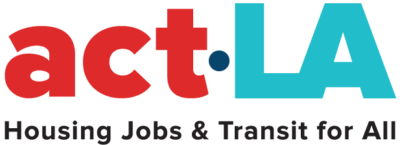Transit Justice Update
In March, we released Metro as a Sanctuary: Reimagining Safety on Public Transit, a report that details our vision towards care-based safety strategies on LA transit—with recommendations for transit ambassadors, outreach for unhoused riders, and other new programs like elevator attendants—instead of the current police-first approach.
The consequences of LA Metro’s current police-first approach to transit rider safety have been disastrous. Over the last five years, LA Metro has spent $786,000,000 (significantly over their originally projected amount) on their contract with the LA Police Department, LA County Sheriff’s Department, and Long Beach Police Department. They have perpetuated cycles of poverty and the criminalization of its riders who are mostly low income and from communities of color: Black riders are 18% of Metro ridership but account for 50% of citations, indicating significant racial profiling on Metro.
Presenting This Report To Our Transit Rider Leaders
Our “Metro as a Sanctuary” series (following the release of the report) began with an in-language Spanish session on “Why we say Black Lives Matter” to build understanding of the painful history of anti-Black racism in the US, contextualize our current transit justice movement, and build solidarity between our transit riders and the Black Lives Matter movement. During this session, riders shared experiences of racism in their families and communities—and we addressed common racist notions shared in our communities that allow for the perpetuation of white supremacy and state-sanctioned violence on Black bodies.
In our second session “A Conversation with Transit Riders: Safety on Metro”, transit riders and organizers shared their experiences while riding Metro buses and trains, including: Experiences of sexual harassment, harrassment from police, altercations among riders, long wait times for and odysseys on transit, and the stress of transit fares on a rider’s income. These shared stories reinforced to the ACT-LA coalition and our transit rider leaders the importance of our transit justice work and why care-based safety is so critical to our communities.
In the third and final session, “Metro as a Sanctuary: Reimagining Safety on Public Transit,” we presented our report findings and our recommended alternatives to policing—and how these alternatives would transform our transit system.
We continue to envision Metro as a sanctuary for our riders and will continue working alongside transit riders towards this vision. Our next step is a 2-day training camp at the end of August to educate our transit rider leaders on their transit rights and mobilize them on upcoming advocacy opportunities.
